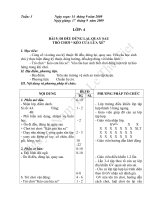- Trang chủ >>
- Mầm non - Tiểu học >>
- Lớp 5
5 2 5 the national guard modern minutemen (social studies)
Bạn đang xem bản rút gọn của tài liệu. Xem và tải ngay bản đầy đủ của tài liệu tại đây (5.34 MB, 14 trang )
Suggested levels for Guided Reading, DRA,™
Lexile,® and Reading Recovery™ are provided
in the Pearson Scott Foresman Leveling Guide.
The National Guard:
Modern Minutemen
by Patricia Walsh
Genre
Expository
nonfiction
Comprehension
Skills and Strategy
• Sequence
• Main Idea
and Details
• Ask Questions
Text Features
•
•
•
•
Captions
Map
Timeline
Glossary
Scott Foresman Reading Street 5.2.5
ISBN 0-328-13531-3
ì<(sk$m)=bdfdbi< +^-Ä-U-Ä-U
The National
Guard:
Reader
Response
Modern
Minutemen
1. In what wars has the
official Army National Guard
been involved? Fill in a timeline like the one below to
list them in their proper sequence. Include the year
by that
Patricia
eachWalsh
war began.
War
Year
2. Think about the book you just read. What are two
questions you’d like to know about the National
Guard that are not answered by the book? Where
could you go to find this information?
3. Which glossary words are verbs? Create a threecolumn chart. In column 1, write the base words. In
column 2, write the words with the inflected ending
-ed. In column 3, write the words with the ending
-ing.
4. Information in nonfiction books can be found in many
places. Look back at the map on page 7. What can you
learn from this map that is not included in the text?
Editorial Offices: Glenview, Illinois • Parsippany, New Jersey • New York, New York
Sales Offices: Needham, Massachusetts • Duluth, Georgia • Glenview, Illinois
Coppell, Texas • Ontario, California • Mesa, Arizona
The Minutemen
In the early days of the American
Revolution, much of the American army
was a volunteer militia. The militia was made
up of citizen-soldiers. These citizen-soldiers
were regular people, mostly farmers. Each
town had a militia that came together to
defend the town from attack.
Some members of the Revolutionary
militia gained the nickname “minutemen”
because they could be ready to fight at a
moment’s notice. The minutemen were
made famous in two poems about the
American Revolution.
Every effort has been made to secure permission and provide appropriate credit for
photographic material. The publisher deeply regrets any omission and pledges to
correct errors called to its attention in subsequent editions.
Unless otherwise acknowledged, all photographs are the property of Scott Foresman,
a division of Pearson Education.
The various uniforms of the
colonial troops
Photo locators denoted as follows: Top (T), Center (C), Bottom (B), Left (L), Right (R),
Background (Bkgd)
Opener: (CL, CR) © Royalty-Free/Corbis, (B) ©DK Images; 1 (T) Getty Images, (C)
Royalty-Free/Corbis; 3 (C) Getty Images, (B) Library of Congress; 4 (T) Getty Images, (BR)
©DK Images; 5 Library of Congress; 7 Getty Imagesl; 8 Library of Congress; 9 (BR) ©DK
Images, (C) Getty Images, (T) Library of Congress; 10 (C) Getty Images, (CR) Library of
Congress; 11 Library of Congress; 12 Library of Congress; 13 Library of Congress;
14 Library of Congress; 16 (CL, B) ©DK Images, (CR) Royalty-Free/Corbis; 17 (B) ©
Royalty-Free/Corbis; 18 Digital Wisdom, Inc.; 19 Getty Images; 20 ©DK Images;
23 Rubberball Productions
ISBN: 0-328-13531-3
Copyright © Pearson Education, Inc.
All Rights Reserved. Printed in the United States of America. This publication is
protected by Copyright, and permission should be obtained from the publisher
prior to any prohibited reproduction, storage in a retrieval system, or transmission
in any form by any means, electronic, mechanical, photocopying, recording, or
likewise. For information regarding permission(s), write to: Permissions Department,
Scott Foresman, 1900 East Lake Avenue, Glenview, Illinois 60025.
2 3 4 5 6 7 8 9 10 V0G1 14 13 12 11 10 09 08 07 06 05
3
In the poem “Paul Revere’s Ride” by Henry
Wadsworth Longfellow, it is the minutemen who
hear Paul Revere’s warning as he rides into their
towns on his horse, or steed. Revere’s message is
that the enemy British troops are coming to their
towns. The militiamen are ready in a minute to
stop the British.
The minutemen were also made famous in these
lines from the poem “Concord Hymn” by Ralph
Waldo Emerson.
In the hour of darkness and peril and need,
The people will waken and listen to hear
The hurrying hoof-beats of that steed,
And the midnight message of Paul Revere.
The “embattled farmers” in Emerson’s poem are
the minutemen. “The shot heard round the world”
refers to the beginning of the American Revolution.
Here once the embattled farmers stood
And fired the shot heard round the world.
The British won
the first battle
at Lexington,
Massachusetts, on
April 19, 1775.
4
5
eR
ive
nc
re
w
.L
St
CLAIMED BY
NEW HAMPSHIRE
AND NEW YORK
L
e
ak
e On
Lak
e
Lak
E ri
tario
NEW
YORK
e
PENNSYLVANIA
a
MAINE
(PART OF
MASSACHUSETTS)
NEW
HAMPSHIRE
MASSACHUSETTS
Boston
son R.
Hud
n
Huro
The United States still relies on citizensoldiers. Today we call them the National
Guard. Each state has U.S. Army and U.S. Air
Force branches of the National Guard. Each
Guard is under the command of its state
governor. When public safety is threatened,
the governor can order the state’s National
Guard to respond. If national security is
threatened, the President can mobilize, or
call up, any state’s National Guard.
RHODE ISLAND
CONNECTICUT
New York City
40˚N
65˚W
NEW JERSEY
Philadelphia
er
Early Militias
Oh
DELAWARE
VIRGINIA
MARYLAND
N
35˚N
NORTH
CAROLINA
Sa
nn
va
ATLANTIC
OCEAN
SOUTH
CAROLINA
ah
GEORGIA
r
ve
Ri
Early colonists found America to be a
dangerous place. They felt the need to
defend themselves from attack, so they
created a volunteer militia. The oldest
colonial volunteer group was the Ancient
and Honorable Artillery Company. It
began in Boston in 1638, long before the
beginning of the American Revolution.
When the American colonists were ready
to declare themselves free from British rule
in 1776, the colonial militias already had
a long tradition of defending their towns
and colonies. Those militias would play an
important role in the American Revolution.
R
io
iv
Charleston
30˚N
New England Colonies
St. Augustine
(Spain)
Middle Colonies
Southern Colonies
25˚N
Gulf of
Mexico
0
The thirteen English colonies
along the Atlantic coast were
prepared to defend themselves
if necessary.
6
0
250
250
500 Miles
500 Kilometers
70˚W
7
Militias in the American Revolution
To gain their freedom from British rule, the
colonists knew they would have to fight the British
army. In 1774 the colonial leaders asked each colony
to ready its militia. In Massachusetts, one-third of
the militiamen prepared to instantly answer a call
to battle. These were the first minutemen. Their
first battle was in Lexington in 1775. Many of
these volunteers later joined the new Continental
Army to fight the British. The leader of this army
was a former militia leader. His name was George
Washington.
One American Revolutionary
War hero, the Marquis de
Lafayette, was from France.
He came to America to
help the colonists win
their freedom from the
British. When he returned
to France, he fought in
the French Revolution. He
called his French troops the
Garde Nationale. In honor
of Lafayette and the help
Ma
tt e
e
rqu
he gave during the American
y
i s d e L af a
Revolution, New York State named
its militia the National Guard.
After the American Civil War (1861–1865), many
states also renamed their militias. They too called
their troops the National Guard. In 1916 the U.S.
government passed a law that said all state militias
would be renamed the National Guard.
8
Above: A U.S. Army recruiting
poster
Below: A U.S. Army snare drum
9
The National Guard in War
Protecting Civil Rights
Many of the most famous Civil War combat units
were militia, not regular army units. One such unit
was the Twentieth Maine, which helped win the
Battle of Gettysburg.
In 1940, more than a year before the United
States entered World War II, the National Guard was
called up to serve
the country. The
National Guard was
also mobilized for the
Korean War in the
1950s. More recently,
the Guard was called
up for both the 1991
Persian Gulf War and
the Iraq War.
The National Guard has also been called to help
where there is trouble at home. For a time in some
places in the U.S., African American children were
not allowed to attend the same schools as white
children. In 1954 the U.S. Supreme Court ruled that
all children have a right to an equal education and
that African American children have the right to
attend the same schools as white children.
In Tennessee some people disagreed with the
Supreme Court’s decision. The governor of Tennessee
called up the National Guard to help him enforce
the law that allowed integration, or the changing of
the schools from all-white. The Guard protected the
children as they walked past angry crowds to enter
the new schools.
In Arkansas, the governor called up his state’s
National Guard to block African American students
from attending the all-white schools. President
Dwight D. Eisenhower had to order the Arkansas
National Guard to enforce the law that said African
American children had the right to
attend those schools. The Guard
followed the President’s orders
and protected the students
as they began to attend
classes in their new schools.
Left to right: the battlefield
at Gettysburg, PA; Civil War
soldiers; President Dwight
Eisenhower
10
11
President John F. Kennedy called on
the National Guard twice to protect the
civil rights of citizens. In 1962 James
Meredith, an African American, wanted
to attend the all-white University of
Mississippi. Many people at that time
were still protesting the integration of
public schools. President Kennedy called
out more than ten thousand members
of the National Guard. The Guard faced
angry protestors and allowed the school
to be integrated.
Then in 1963 Governor George Wallace
of Alabama stood in the way of two
African American students who wanted
to enroll at the University of Alabama.
But integration was the law, so President
Kennedy ordered the Alabama National
Guard to protect the
students’ rights. He
wanted the Guard
to make sure
that all students
could enroll at
the university.
Once again the
Guard obeyed the
President instead
of the governor.
President John F. Kennedy
12
Governor George Wallace
13
The National Guard Called to Cities
In the summer of 1966, the tension over civil
rights resulted in fighting in several cities across
the country. The National Guard was called up to
restore order. In Chicago, Illinois, the National Guard
answered the call to protect the city. Four thousand
Guard members, trained in riot control, were on the
scene the same day that the governor called them up.
In Dayton, Ohio, one thousand members of the
Guard were called out to stop the rioting. They
rode along with policemen in police cars. They also
patrolled the streets and guarded stores. The riots
in Dayton ended three days later with the help from
the Guard.
In San Francisco, California, more than three
14
thousand members of the Guard were called up to
help stop a riot. Many members of the Guard had
served during other California city riots and were
trained for riot control. Using helmets and shields,
the Guard controlled angry crowds and rapidly
cleared the streets.
The following year in Milwaukee, Wisconsin,
three thousand Guard members were called out to
try to keep a riot from tearing apart the city. The
Guard stopped all traffic to keep peace in the streets.
Three days later, the Guard finally went home.
In the 1960s, people organized
peaceful marches to protest
inequality and the lack of civil
rights for African Americans.
15
Training for the National Guard
Providing Rescue and Relief
Service in the National Guard begins with IET,
or Initial Entry Training. In IET, the members of the
Guard learn to live outdoors, to fight, and to stay
safe. After IET, they usually train for one weekend
each month and go to a twoweek training period each
year. The two-week
training time is usually
held in the summer.
Many members of
the Guard use their
vacation time for
summer training.
The National Guard is always ready for rescue
and relief duty in emergencies and disasters. They
help when natural disasters strike in the form of
hurricanes, floods, tornadoes, heavy snowfalls, bitter
cold, and drought.
During hurricanes, Guard members get through
rising water in special trucks to evacuate stranded
people. After tornadoes, the Guard cleans up fallen
trees. At the height of blizzards, the Guard uses its
big vehicles to rescue snowbound drivers and to
clear roads. The National Guard is also ready to set
up emergency generators to provide electricity when
bad weather knocks down power lines. And Guard
members give emergency medical help if people are
hurt. They have even donated their own blood to
help injured people.
The National Guard can help in other emergencies
too. Its helicopters are used to drop water on forest
fires or fly injured hikers out of the mountains.
They are also used to search for missing skiers and
snowboarders.
F-16 fighter jet
M1 Abrams tank
16
17
The National Guard in the World
Protection of Citizens
The National Guard may be called upon to go to
other countries around the world.
When the Iraqi army invaded its smaller neighbor
Kuwait in August 1990, the National Guard was
called up by President George H. W. Bush to go to
Kuwait. More than sixty thousand Army National
Guard men and women were called up. When the
Gulf War began in January 1991, thousands of Guard
members went overseas.
The National Guard can move quickly when
Americans are in need of protection. They direct
traffic and control the crowds when the job is too
big for local police. They also guard bridges, tunnels,
and railroad and bus stations when extra protection
is needed.
When asked, the National Guard patrols the
nation’s nuclear power plants and water reservoirs.
They also have watched over the nation’s airports.
The Guard protected the world’s athletes during
the 1996 Summer Olympics in Atlanta, Georgia, and
the 2002 Winter Olympics in Salt Lake City, Utah.
Decisions to send the National
Guard to countries all over the
world are made at the U.S.
Pentagon (below).
18
19
Women in the National Guard
The National Guard Museum
At one time, the only women in the National
Guard were nurses. This nurses-only rule was
officially changed in 1967. The new rules allowed
women to do many other military jobs too. The
change in rules encouraged more women to join
the Guard. Today there are more than thirty-five
thousand women in the National Guard. Women
perform many of the same functions as men,
including combat roles. Like the men, they serve
wherever they are needed.
The National Guard Memorial Museum in
Washington, D.C., tells people about the National
Guard. It helps people understand why everyday
citizens leave their jobs, families, and safety to
serve in the National Guard. Visitors learn about the
history of the Guard and its role in war and in peace.
Like the minutemen of years ago, the men and
women of today’s National Guard are quick to
respond when called. They stand ready to become
full-time soldiers if needed. They are ready to protect
the people and property in each state. They are also
ready to put aside their everyday lives to defend the
United States at home and around the world.
A Historical Timeline: 1775 – 2003
1941
U.S. Enters
World War II
1775
Minutemen at
Lexington, MA
1800
1861
American
Civil War
1917
U.S. Enters
World War I
2003
Iraq War
1950
Korean War
1954
Defending
Civil Rights
1962–63
Defending
Civil Rights
1996, 2002
Protecting
Olympic Athletes
1991
Gulf War
1900
2000
1916
Army National Guard
Officially Formed
20
1966–67
Riots in
American Cities
21
Now Try This
Call Up the National Guard!
Every state has a National Guard. It is under the
command of the governor of the state. Each state
has National Guard armories, or buildings where
members of the Guard meet, train, and keep their
equipment.
Find out about your state’s National Guard,
or choose another state to investigate. Use Internet
or library resources to find the answers to the
following questions.
• Decide which state’s National Guard you
are going to research.
• Who is the governor of the state?
• What is the population of the state?
• How many men and women currently
serve in the state’s National Guard?
• Where is the state’s National Guard
headquarters?
• How many National Guard armories
are there in the state?
• What is one peacetime or wartime
event in which this state’s National Guard
participated?
• How long do people serve in the
National Guard?
• What are two jobs in the National Guard
that a Guard member might do?
22
to Do It!
w
o
H
s
’
e
r
He
Now display your information in an easy-toread format, such as a chart or a poster. Be sure to
use a heading on your chart that tells which state’s
National Guard you are presenting. Draw a patch,
or shoulder sleeve insignia, that someone serving
in this state’s National Guard might wear on his or
her uniform. Attach your drawing to your chart or
poster. Then share and compare your information
with your classmates.
My State
National Guard
23
Reader Response
Glossary
citizen-soldiers n. people
who are usually civilians
but who can be called
upon to be soldiers in
times of peace or war.
defending v. protecting
something or someone
from harm.
mobilize v. call into active
military service; organize
for war.
National Guard n. trained
military force of volunteer
citizen-soldiers serving
their state and nation.
relief n. aid; help.
riot n. a large group of
people becoming noisy
and out of control.
1. In what wars has the official Army National Guard
been involved? Fill in a timeline like the one below to
list them in their proper sequence. Include the year
that each war began.
steed n. a high-spirited
riding horse.
War
troops n. soldiers.
Year
volunteer adj. formed or
made up of volunteers,
people who serve from
their free will, not because
they are forced to.
2. Think about the book you just read. What are two
questions you’d like to know about the National
Guard that are not answered by the book? Where
could you go to find this information?
3. Which glossary words are verbs? Create a threecolumn chart. In column 1, write the base words. In
column 2, write the words with the inflected ending
-ed. In column 3, write the words with the ending
-ing.
4. Information in nonfiction books can be found in many
places. Look back at the map on page 7. What can you
learn from this map that is not included in the text?
24









